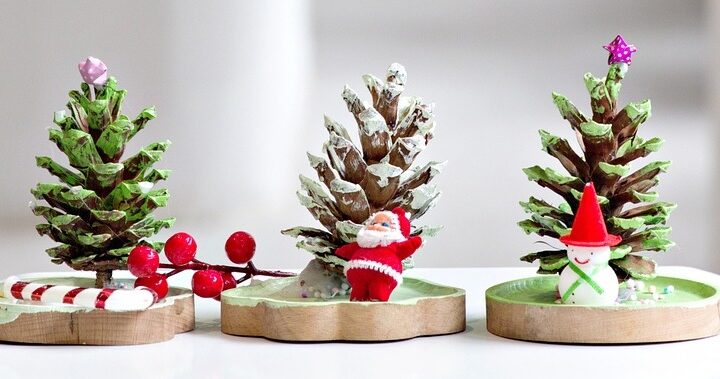As the festive season approaches, many people look forward to decorating their homes and offices. Yet the symbols of Christmas need not carry religious connotations: universal values such as generosity, belonging, renewal, joy and stewardship resonate across cultures. Feng shui – the Chinese art of aligning spaces with natural energy flows – offers a framework for expressing these values without superstition. Modern research shows that well‑designed environments influence mood, cognition and health. Exposure to natural elements can reduce stress and improve physical health, while cluttered spaces increase cortisol levels and hamper concentration. Designers are also integrating neuroscience, biophilic design and circadian lighting to create brain‑friendly buildings. This article draws on these findings and the latest design trends to present a practical guide for Christmas 2025. It translates evidence‑based principles into actionable tips for homes and workplaces of different sizes, emphasising low‑cost adjustments, sustainability, inclusive hosting and a mindful post‑holiday reset.
Entry: welcoming energy and clarity
The entry sets the tone for your festive experience. In feng shui, the front door symbolises the ‘mouth of chi’, where energy enters. To invite generosity and belonging:
Tip box – quick‑start entry checklist
-
Clear the pathway: remove clutter and shoes to avoid tripping and to reduce visual stress. Clutter has been linked to increased cortisol and difficulty focusing.
-
Light the way: use warm white LED lights or solar lanterns to illuminate the walkway. Natural light and warm colours promote relaxation and circadian rhythm regulation.
-
Natural greenery: place seasonal plants, such as pine branches or holly in recycled containers, on either side of the door. Plants introduce biophilic elements that reduce stress and improve air quality.
-
Sound and scent: hang a soft wind chime or bell for a gentle sound cue, and use natural essential oils (citrus or pine) instead of synthetic fragrances. Research into restorative design highlights that multisensory elements, including soundscapes and scents, enhance mental restoration.
Step‑by‑step actions
-
Declutter the threshold. Dedicate five minutes to tidying shoes and coats. Provide a small basket for keys and mail to avoid clutter on surfaces. Keeping the entrance clear helps people feel welcomed and reduces stress.
-
Create a gentle light gradient. If your hallway lacks natural light, install a dimmable lamp or fairy lights along the wall leading to the main living area. According to neuroaesthetic research, appropriate lighting and cool hues reduce blood pressure and promote calm.
-
Introduce a reflective surface. Hang a small mirror near the entry to bounce light and create a sense of space. In feng shui, this symbolises clarity and allows guests to tidy themselves upon arrival.
-
Honour stewardship through materials. Use reclaimed wood or second‑hand planters for seasonal displays. Sustainable materials support ecological values and align with 2025 design trends that prioritise recycled sources.
Living and dining: flow, belonging and nourishment
Festive gatherings centre on the living and dining areas. These rooms should support social connection, inclusive movement and sensory comfort.
Tip box – living and dining quick checks
-
Arrange seating in a circle or horseshoe. Symmetrical seating fosters conversation and belonging. Avoid placing chairs with backs to the door.
-
Manage the fire element. Candles and fireplaces introduce warmth and passion; balance them with the calm of natural greenery, water features or cool colours.
-
Use biophilic textures. Incorporate wood, linen and wool to create a grounded, welcoming atmosphere. Natural materials engage the senses and promote restorative effects.
-
Control sound levels. Use soft rugs, curtains and cushions to absorb noise, supporting acoustic comfort. Biophilic design emphasises acoustic management as part of human‑centred design.
-
Check walkway widths. Leave at least 90 centimetres between furniture pieces to allow easy circulation for all ages and abilities.
Step‑by‑step actions
-
Define zones. In open‑plan spaces, use rugs or furniture placement to delineate conversation areas and dining zones. This helps manage energy flow and reduces chaos. Avoid placing the sofa or dining table directly in line with the entry to minimise draughts.
-
Position the tree thoughtfully. If you have a Christmas tree, place it where it does not block circulation from the door to seating. A corner opposite the entry allows energy to circulate while making the tree a focal point for joy.
-
Optimise lighting layers. Combine overhead lighting with floor lamps and table lamps. Use warm, dimmable bulbs during gatherings to foster intimacy, and incorporate natural daylight whenever possible.
-
Sustainable décor. Choose reusable decorations (fabric bunting, handmade ornaments) and avoid single‑use plastics. Live plants like poinsettias can be re‑potted after the season. According to 2025 trends, sustainable materials and local sourcing are central to biophilic design.
-
Create a gratitude centrepiece. Encourage guests to write notes of appreciation and hang them on a branch or ribbon. This practice reinforces generosity and belonging without religious framing.
-
Balance stimulation and rest. Provide a quiet corner with soft lighting and cushions for anyone needing a break from social interaction, aligning with neuroaesthetic principles that emphasise sensory balance.
Kitchen: nourishment and stewardship
The kitchen symbolises nourishment and communal labour. During Christmas, it often becomes overcrowded and chaotic. A few mindful adjustments can enhance function and harmony.
Tip box – kitchen quick checks
-
Clear countertops. Keep only essential tools visible; store small appliances to reduce clutter and cognitive load.
-
Organise traffic flow. Designate separate areas for prep, cooking, and serving. Encourage helpers to move clockwise to avoid collisions.
-
Integrate plants and herbs. Fresh herbs on the windowsill provide fragrance and a link to nature.
-
Healthy lighting. Use task lighting for safety and natural light by day; avoid harsh overhead brightness at night to support circadian rhythms.
-
Sustainable practices. Set up recycling and compost bins near the workspace; use cloth napkins and beeswax wraps.
Step‑by‑step actions
-
Tidy and zone the space. Before festivities begin, clear work surfaces and group utensils by task. Clutter increases stress and impairs focus.
-
Install a herb station. A small indoor herb garden near a window brings greenery into the kitchen and provides fresh flavours. Plants can improve air quality and mental well‑being.
-
Mindful lighting plan. Fit under‑cabinet LED strips for prep areas and dimmable ceiling lights. Warm colour temperatures in the evening help maintain melatonin production and sleep quality.
-
Encourage stewardship. Provide clearly labelled bins for recycling, compost and general waste. Use cloth towels instead of paper and choose refillable cleaning products.
-
Plan inclusive tasks. Assign roles suited to guests’ abilities. For example, children can wash vegetables, while elderly relatives sprinkle herbs. This fosters belonging and reduces chaos.
-
Add calming elements. A small fountain or recorded water sounds can reduce stress while cooking.
Bedroom and sleep: renewal and quiet joy
Sleep is essential for restoration during the busy festive season. Bedrooms should support circadian rhythms and sensory balance.
Tip box – bedroom quick checks
-
Remove electronics. Blue light from screens disrupts melatonin; store devices outside the bedroom.
- Check for geopathic stress. Install a Schumann Resonance harmoniser Helios3USB for electrosmog and geopathic stress
-
Calming colours and textures. Soft blues, greens and neutral shades lower blood pressure and promote relaxation. Use natural fabrics (cotton, linen) for bedding and curtains.
-
Optimise lighting. Install blackout curtains or blinds to minimise light pollution. Use warm bedside lamps and avoid bright overhead lights.
-
Air quality and scent. Ventilate daily and use beeswax candles or essential oils like lavender for relaxation.
-
Clutter control. Keep surfaces clear; clutter can hinder relaxation and reduce sleep quality.
Step‑by‑step actions
-
Create a sleep ritual. Dim lights an hour before bed; incorporate gentle stretching or reading. Research shows that exposure to cool hues and natural daylight supports circadian rhythms.
-
Position the bed for safety and support. In feng shui, place the bed diagonally across from the door so you can see but not align with it. Ensure the headboard is solid and place a soft rug underfoot.
-
Incorporate nature. A small potted plant (e.g., peace lily) adds humidity and improves air quality. Avoid spiky or thorny plants.
-
Limit festive décor. If you wish to decorate the bedroom, use subtle touches (a string of fairy lights on the headboard) rather than bright colours or flashing lights that may disturb sleep.
-
Declutter the wardrobe. Before the season, donate unused clothing. Creating space symbolises renewal and encourages letting go of the old year.
Home office and small workplaces: focus, flexibility and boundaries
Many people continue to work remotely or hybrid, even during the festive period. Small offices or dual‑purpose rooms require careful planning to maintain productivity while accommodating celebrations.
Tip box – home office quick checks
-
Define the boundary. Use a folding screen, curtain or bookshelf to separate the work area from festive décor. Clear boundaries help maintain focus and prevent work‑life spill‑over.
-
Natural light and circadian lighting. Position your desk near a window to access daylight; supplement with adjustable task lighting. Exposure to daylight improves mood and productivity.
-
Ergonomics. Invest in an adjustable chair and desk; supportive seating enhances comfort and reduces fatigue.
-
Acoustic control. Use area rugs, wall hangings and noise‑absorbing materials to reduce distractions. Sound control is part of human‑centred design.
-
Posture and flow. Keep the desk free from piles of paper. Clutter can distract and decrease focus.
Step‑by‑step actions
-
Schedule work hours. Agree with household members on specific work periods. Use a visual cue (e.g., a closed curtain or sign) to signal when you are working. This maintains boundaries and respect.
-
Optimise desk placement. Ideally, position your desk so you can see the door but are not directly in line with it, supporting a sense of security.
-
Cable management. Use clips or cable sleeves to organise cords. This reduces tripping hazards and visual clutter.
-
Integrate greenery. A small plant on your desk or shelf provides micro‑restoration and improves cognitive performance.
-
Plan a post‑work ritual. At the end of the day, tidy your desk, close your laptop and turn off the lights. This signals the transition to leisure.
-
Communicate with colleagues. If remote meetings coincide with holiday arrangements, inform colleagues of your boundaries. Use earphones to reduce ambient noise.
Shared buildings and neighbours: stewardship and community
In apartment blocks or shared buildings, communal spaces and neighbours contribute to the festive atmosphere. Small gestures can foster goodwill and collective stewardship.
Tip box – communal space quick checks
-
Respect shared areas. Remove decorations from hallways that obstruct movement or create hazards.
-
Light and safety. Check communal lighting and report any outages. Use battery‑operated candles in shared displays to reduce fire risk.
-
Inclusive celebrations. Invite neighbours to a casual festive gathering (e.g., on the staircase or courtyard), emphasising universal values rather than religious narratives.
-
Recycling stations. Collaborate on shared recycling points for gift packaging and wrapping paper.
-
Noise awareness. Agree on quiet hours and keep music at moderate levels.
Step‑by‑step actions
-
Coordinate décor. Discuss with neighbours which areas can be decorated and ensure displays align with building regulations. Use natural, reusable materials.
-
Encourage mutual care. Offer to water each other’s plants or collect mail when someone is away, reinforcing belonging.
-
Organise a charity drive. Collect non‑perishable food or clothing donations for a local charity. Generosity ties into the universal spirit of the season.
-
Set up a book or toy swap. Sharing resources reduces consumption and builds community.
-
Maintain clear exits. Ensure that emergency exits and stairways remain free of obstructions for safety.
Post‑holiday reset: renewal and clarity for January
After the celebrations, taking time to reset your environment helps integrate lessons from the year and prepare for a fresh start.
Tip box – post‑holiday reset quick checks
-
Remove decorations mindfully. Store reusable items in labelled boxes; recycle or compost organic décor. Avoid discarding usable items.
-
Deep clean and declutter. Donate gifts or items you will not use; clutter can lower subjective well‑being.
-
Refresh air and light. Open windows to ventilate and let in winter sunlight. Natural light regulates circadian rhythms and mood.
-
Reflect and set intentions. Journal or share with family what brought you joy, clarity and prosperity. Choose one small change for belonging, one for clarity and one for prosperity.
-
Plan for the new year. Create a simple monthly plan for maintaining order and integrating sustainable practices.
Step‑by‑step actions
-
Schedule a decluttering day. Dedicate a day in early January to sort through decorations, gifts and clothes. Use the question: “Have I used this in the last year?” to decide whether to keep, donate or recycle.
-
Adopt a one‑in, one‑out rule. For every new item brought in during the holidays, donate or recycle an old one. This keeps belongings in balance.
-
Reset lighting routines. Adjust lighting to support early sunsets; use bright white light in the morning and warm tones in the evening to align circadian rhythms.
-
Introduce a gratitude board. Keep a noticeboard where family members can write moments of gratitude or aims for the year ahead.
-
Review energy consumption. Analyse electricity and heating use during the holidays and set goals for reduction. Smart wellness ecosystems emphasise energy monitoring and occupant wellbeing.
-
Celebrate progress. Host a simple meal to celebrate a clutter‑free, harmonious space and thank those who contributed to the reset.
Q & A
How can I balance festive lights with sleep hygiene? Use warm white LED lights and switch them off at least an hour before sleep. Natural daylight exposure during the day, combined with warm light in the evening, supports circadian rhythms. Avoid flashing or blue‑tone lights in bedrooms.
What can I do if my flat is small? Opt for space‑saving decorations such as wall‑mounted trees or branches in vases. Declutter before decorating to free up surfaces. Use vertical storage and foldable furniture to maximise floor space. Biophilic workspaces for hybrid offices emphasise flexible layouts and natural light.
How can I make decorations more sustainable? Choose reusable decorations made from natural materials (wood, fabric), rent or borrow special pieces, and incorporate DIY projects using recycled items. Embrace living decorations like potted plants, which can thrive beyond the season. Trends for 2025 highlight sustainable materials and local sourcing.
How do I maintain boundaries in hybrid work during the holidays? Set clear schedules and communicate them to household members. Use physical barriers like screens to separate work zones. Tidy your workspace at the end of each day to signal completion and to reduce visual clutter, which can otherwise raise stress.
What if I cannot invite guests due to space or personal reasons? Focus on virtual gatherings or small outdoor meet‑ups. Share festive experiences by sending handwritten notes or photos of your décor. The universal values of generosity and belonging can be expressed through acts of kindness, such as donating to charity or supporting a neighbour, even if you do not host a party.
Closing reflection: choosing change for belonging, clarity and prosperity
As you prepare for Christmas 2025, consider the deeper purpose of your festive choices. By aligning your environment with universal values, you create spaces that nurture harmony and prosperity for everyone. Choose one small change for belonging, such as inviting a neighbour for tea or organising seating for an inclusive conversation. Choose one change for clarity, perhaps by decluttering your wardrobe or setting clear boundaries between work and leisure. Finally, choose one change for prosperity, such as adopting sustainable décor or investing in ergonomic furniture for your long‑term well‑being. These steps, grounded in feng shui and supported by contemporary research, can transform your surroundings into a sanctuary of joy, renewal and mindful stewardship.
Five‑minute festive fixes
-
Sweep your doorway and add a small potted plant to invite fresh energy and belonging.
-
Clear your dining table of non‑essentials and set out a natural centrepiece of evergreen branches.
-
Tidy your desk and place a green plant or crystal to support focus.
-
Replace a synthetic candle with a beeswax candle for cleaner air and a calming scent.
-
Swap one string of flashing lights for a warm, steady glow to support sleep hygiene.
-
Designate a donation bag for unwanted gifts or items and fill it immediately after unwrapping.
-
Open a window for five minutes each day to refresh the air and let in natural light.
-
Take three deep breaths at your decorated natural Xmas tree, appreciating the moment and grounding yourself in joy.
- And most importantly, have fun – it’s a celebration!








